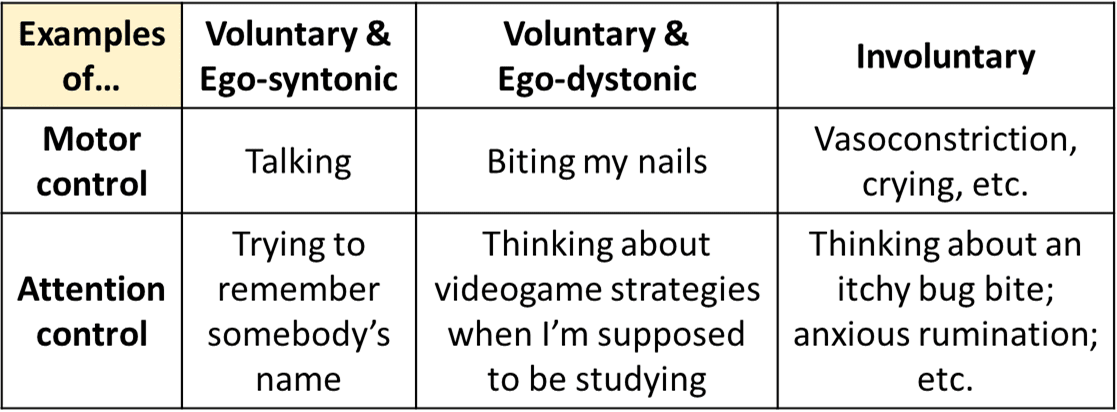Pleasure and suffering are not conceptual opposites. Rather, pleasure and unpleasantness are conceptual opposites. Pleasure and unpleasantness are liking and disliking, or positive affect and negative affect, respectively.[1]
Imagine an experience of suffering that involved little or no effects on your attention. It's easy to ignore, along with whatever is causing it and whatever could help relieve it. We (or at least, I) would either recognize this as at most mild suffering, and perhaps not suffering at all.
Our concept of suffering probably includes both unpleasantness and desire (or wanting), which is mediated by motivational salience (or incentive salience and aversive/threat/fearful salience), a mechanism for pulling our attention (Berridge, 2018).[2] I'd guess the apparent moral urgency we assign to intense suffering requires intense desire, and so strong effects on attention. We wouldn't mind an intensely unpleasant experience if it had no effects on our attention,[3] although it's hard for me to imagine what that would even be like. I find it easier to imagine intense pleasure without strong effects on attention.

Pleasure and unpleasantness need not involve desire, at least conceptually, and it seems pleasure at least does not require desire in humans. Desire, as motivational salience, depends on brain mechanisms in animals distinct from those for pleasure, and which can be separately manipulated (Berridge, 2018, Nguyen et al., 2021, Berridge & Dayan, 2021), including by reducing desire (incentive salience) without also reducing drug-induced euphoria (Leyton et al., 2007, Brauer & H De Wit, 1997). Berridge and Kringelbach (2015) summarize the last two studies as follows:
human subjective ratings of drug pleasure (e.g., cocaine) are not reduced by pharmacological disruption of dopamine systems, even when dopamine suppression does reduce wanting ratings (Brauer and De Wit, 1997, Leyton et al., 2007)
On the other hand, in humans and other animals, the aversive salience of physical pain may not be empirically separable from its unpleasantness (Shriver, 2014), but as far as I can tell, the issue is not settled.
- ^
Or specifically the conscious versions of these. On the possibility of unconscious liking and unconscious emotion, see Berridge & Winkielman, 2003 (pdf) and Winkielman & Berridge, 2004.
- ^
And perhaps specifically aversive desire, i.e. aversive/threat salience.
- ^
This could be true by definition, if "to mind" is taken to mean "to pay attention to" or find aversive (aversive salience), at least while experiencing the unpleasantness.


Most of my conception of suffering doesn't feel captured by either of these.
I think suffering does not require unpleasantness (you might agree) - consider mental suffering that occurs in absence of {'unpleasant' experience, such as physical pain, or such as this post's taste example}. I'd say suffering can occur in response to[1] those, as well as in response to other things. For example, watching a bug trying and unable to to roll back onto its legs can cause empathy/sadness, but there's no 'unpleasant sensual experience' here, at least for me (I consider the visual experience to be neutral).
I don't feel that 'desire/wanting' explains of mental suffering what 'unpleasantness' does not. I guess you could say that I want this situation to be different / not happening, and that would be true, but that doesn't feel like the source of the sadness to me, nor do I feel that that 'wanting' is itself suffering.
(Note: I'm relying on my subjective sense of what 'desire/wanting' means, because they were undefined in the post)
If you want to address my view, I think it could be helpful to list some examples of suffering and identify the 'desire/wanting' in each of them.
I'm unsure if I consider both {the sensory experience of physical pain} and {the internal mental/psychological reaction to it} to be suffering, or if I consider only the latter to be suffering. I lean towards 'only the latter', though to not mislead anyone, I want to be clear that in my view extreme physical pain still causes extreme internal suffering for a large class of Earthen life forms.
Unpleasantness doesn't only apply to sensations. I think sadness, like as an empathetic response to the bug struggling, involves unpleasantness/negative affect. That's the case on most models, AFAIK. I agree (or suspect) it's not the sensations (visual experience) that are unpleasant.
To add to this, there’s evidence negative valence depends on brain regions common to unpleasant physical pain, empathic pains and social pains (from social rejection, exclusion, or loss) (Singer et al., 2004, Eisenberger, 2015). In particular, the title of Singer et al., ... (read more)